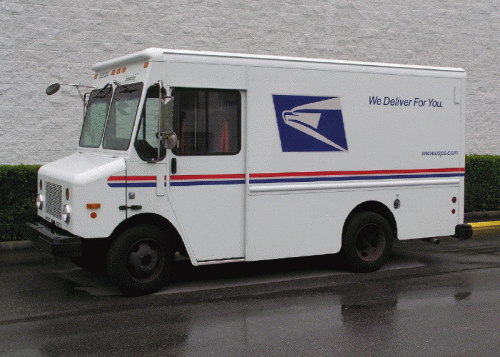
A long time ago, most mail was delivered in this country by one of two methods. Human power, or horse power (like the kind that eats oats). But in recent years a fleet (some would say a hoard) of tiny white post office trucks have sprung up around this country. In some places they litterly drive from suburban mail box, to suburban mail box. All those little truck/car vehicles use up a lot of gas, and in these days of high gas prices a lot of money as well. The good ole, USPS is thinking about doing something about that
The U.S. Postal Service plans to identify new, more environmentally friendly vehicle technologies that are less dependent on petroleum-based fuel sources to replace the 195,000 (!) neighborhood delivery vehicles of its total 220,000 (!!) vehicles, the world’s largest civilian fleet. This announcement came during a ceremony in which General Motors presented a Chevrolet Equinox Fuel Cell electric vehicle to the Postal Service for testing in a mail-delivery environment.
“We are looking for a vehicle that operates from a fuel source that reduces—or eliminates—our dependence on petroleum products, that is good for the environment, good for our customers and good for the Postal Service,†said Walter O’Tormey, vice president, Engineering, as he accepted the keys to the Equinox Fuel Cell that will be tested in Irvine, CA.
Moving forward with non-petroleum fueled vehicles is more important to the Postal Service than ever, O’Tormey said, since a one-cent increase in a gallon of fuel adds $8 million annually to Postal Service expenses. Fuel costs last year were $1.7 billion and are expected to increase this year by $600 million.
“The Postal Service has been an invaluable partner, and they put our fuel cell vehicles through some tough, daily workouts,†said Mary Beth Stanek, director of energy and environmental policy & commercialization at General Motors. “We are gaining valuable insight on how these vehicles perform in demanding, real-world situations. By participating in Project Driveway, the Postal Service also is demonstrating the need to develop a hydrogen infrastructure to support fueling these vehicles.â€
A hydrogen fuel cell vehicle is twice as efficient as an internal combustion engine and is unique in that the fuel cell emits only water vapor which doesn’t harm the environment. The obvious flaw here is that there currently exists no hydrogen infrastructure in this country to speak of, and it takes energy to create hydrogen (most often from natural gas). It would be much easier if the cars were all electric/battery vehicles. Hell you could put solar panels on the roof, and a wind turbine at every charging station and run them on mostly renewable energy! But when have big American auto companies listened to reason?
“We are very encouraged by GM’s fuel cell technology,†O’Tormey added. “We also want to explore other options, such as hybrid electric, plug-in hybrid and other ‘green’ vehicles that will help us continue to provide our customers with reliable service while protecting the environment.†Well that’s a start…but come on guys there has never been a more compelling case for a large fleet of electric/battery vehicles! They all get parked at one location at night for easy charging, they have flat roof for solar panels, and most of them don’t need to go far, or fast (not that electric cars can’t go far or fast, but this would keep costs down).
In a slightly better note the Postal Service leads the federal government in the number of alternate fuel vehicles it uses. More than 43,000 can operate on hybrid-electric, electric, compressed natural gas, liquid propane gas, ethanol (E-85), biodiesel and hydrogen fuel cell. No word how how many of each type there are. I hope its not mostly ethanol, with a smattering of the others.